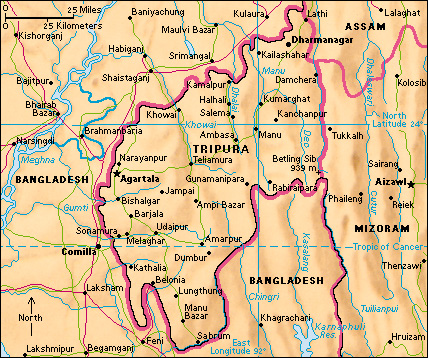Tripura (pop. 3,673,917) is a small, mainly agricultural state in northern India. It is partly mountainous with several deep river valleys. It is located in the monsoon belt (see Monsoon). The moist, mountainous areas of the state have a rich cover of evergreen forest. The south is more open and densely populated. The capital of Tripura, Agartala, is in the southern part of the state. The state covers an area of 4,049 square miles (10,486 square kilometers).

People and government.
About 85 percent of the people of Tripura are Hindus. Most of the rest are Muslims, with small minorities of Christians and Buddhists. About two-thirds of the population speak Bengali. Tripuri and Manipuri are also widely spoken languages.
Tripura has two elected members in the Lok Sabha (lower house) and one nominated representative in the Rajya Sabha (upper house) of the Indian national parliament. The state legislative assembly has 60 members.
Economy.
Rice is the main food crop of Tripura. It is well suited to the marshy areas of the northern valleys and the low-lying plain in the south. Jute and tea are major cash crops. Corn, cotton, fruit, mesta, mustard, and sugar cane are also grown. Mesta is a plant grown for its fiber, which is used to make sacking and rope.
Manufacturing.
Tripura’s manufacturing activities include the processing of cash crops such as jute and sugar cane. Factories process such items as food, tea, rubber, and timber. Small manufacturing industries are developing in the state with government encouragement. Basket making, carpentry, pottery, and weaving are common. Other products include aluminum utensils, leather goods, plywood, and steel furniture. Tripura also has flour and rice mills and sawmills. Sal, an Indian hardwood, and charcoal are the main forest products. Sericulture (the rearing of silkworms for the production of raw silk) is another important industry.
Transportation.
The only convenient means of travel to Agartala is by air. There are daily flights to and from Kolkata, in West Bengal, as well as connections to Gauhati and Silchar, both in Assam.
Tripura is a great distance from major Indian cities. Kolkata is more than 1,120 miles (1,800 kilometers) away, Gauhati 370 miles (600 kilometers), and Shillong 310 miles (500 kilometers) away. A road and rail network connects Tripura to other cities in India.
Land.
Tripura is a hill state in northeastern India. Bangladesh surrounds it on the north, west, and south. The Indian states of Mizoram and Assam border it on the east and northeast. The north of the state consists of four valleys, separated by ranges of hills. The most easterly range rises to nearly 3,300 feet (1,000 meters). Northward-draining rivers include the Deo, the Dhalai, the Khowai, and the Manu. The Gumti and its tributaries drain the plain in southern Tripura. Much of the original evergreen forest has now been cleared. Sal is the dominant species. Like its neighboring hill regions, Tripura has many wild animals, including elephants, tigers, wild boar, wild buffalo, and the world’s largest ox, the gaur.
Climate.
During the monsoon season, from June to September, most of Tripura receives more than 79 inches (200 centimeters) of rain. Annual totals can reach more than 98 inches (250 centimeters). Temperatures in the mountains do not rise as high as they do in the valleys.
History.
The early history of the Tripura region is lost in legend. The name Tripura appears on pillars of the emperor Ashoka, who ruled India in the 200’s B.C.
In the A.D. 1300’s, Tripura came under the control of the Manikya dynasty. Under the Manikyas, the political influence of Tripura extended over Assam, Bengal, and Burma (now Myanmar). In the 1600’s, the Mughal emperors came to rule much of Tripura. But the local Manikya kings, or maharajahs, still retained some of their power. In the late 1700’s, the parts of Tripura that had been ruled by the Mughals came under British control. As part of the province of eastern Bengal and Assam, Tripura was known as Hill Tippera.
During the 1800’s and 1900’s, two Manikya maharajahs stood out as fine rulers of Tripura. Birchandra Manikya Bahadur (ruled 1862-1896), an accomplished poet and musician as well as a politician, sought to modernize the state by reorganizing its administration and abolishing slavery and suttee (see Suttee). Bir Bikram Kishore Manikya Bahadur (ruled 1923-1947) set up a project to improve educational development in the arts and sciences, agriculture, medicine, and technology. Maharajah Bir Bikram also opened the airport at Agartala and established a college in the eastern part of the city. The college still bears its founder’s name.
Following the death of Bir Bikram in 1947, Tripura prepared to become part of an independent India. It entered the Indian Union in October 1949 and became a union territory in 1956. Tripura became a state of the Republic of India in 1972.
